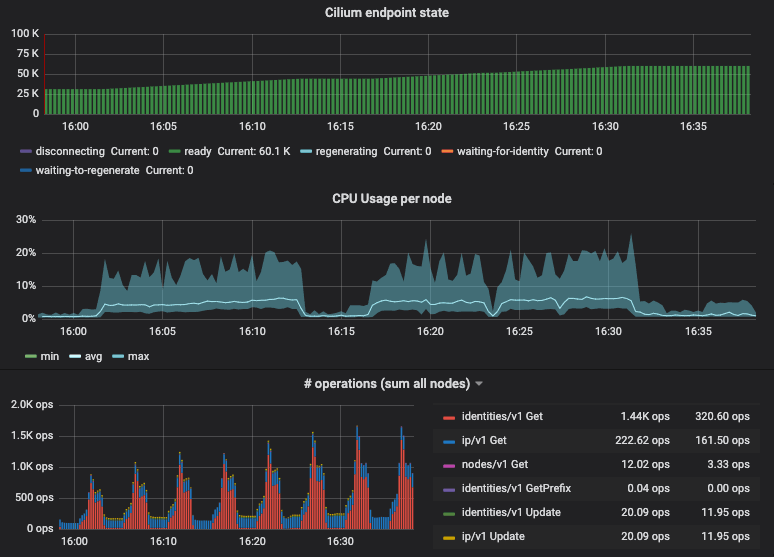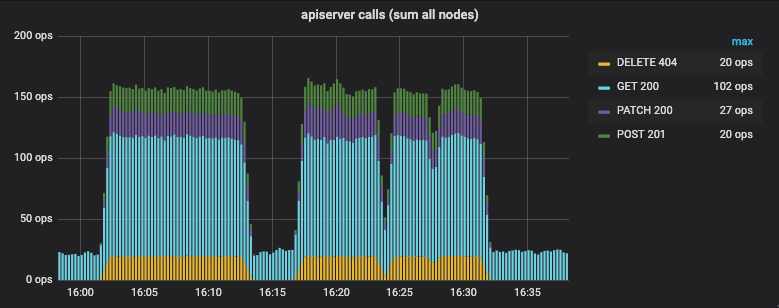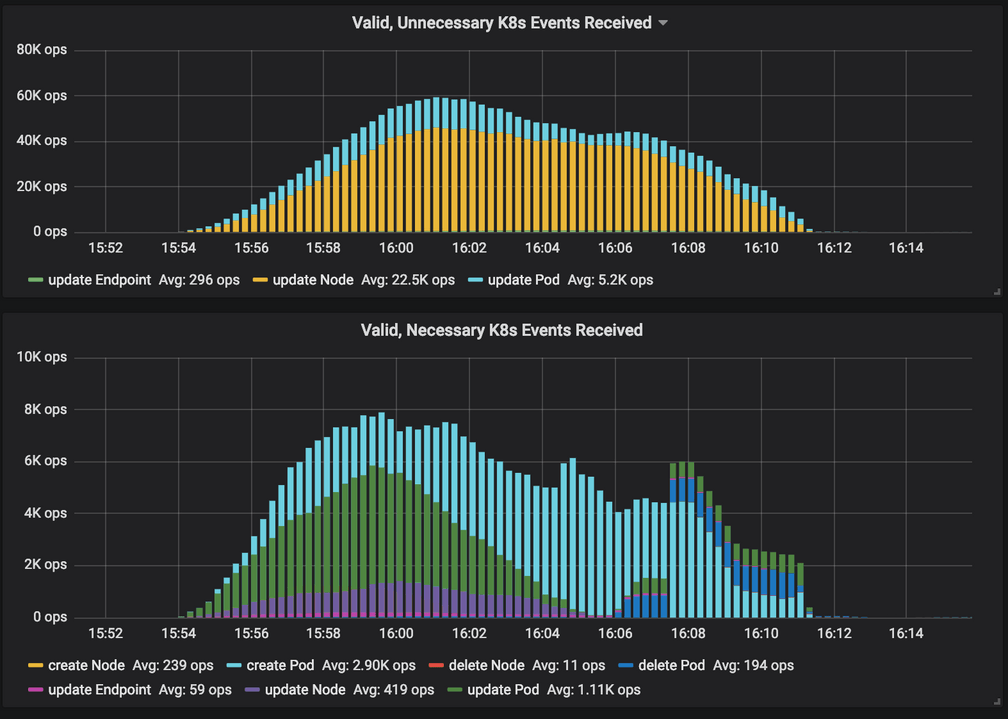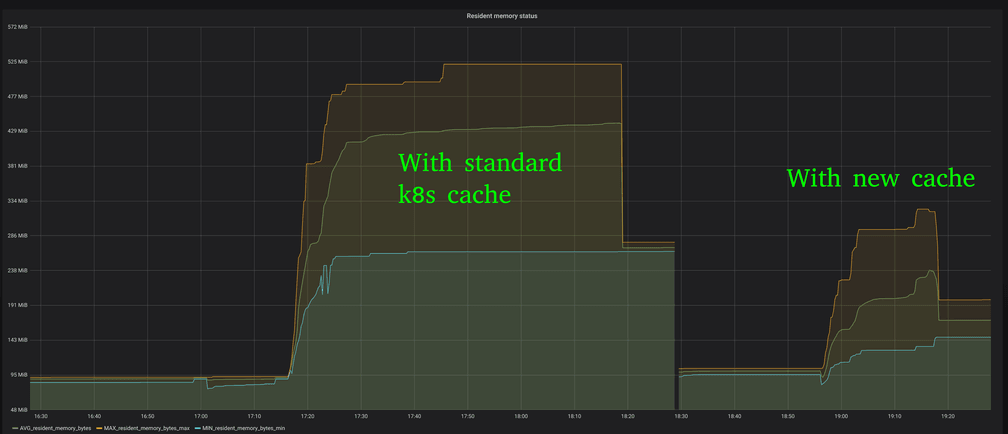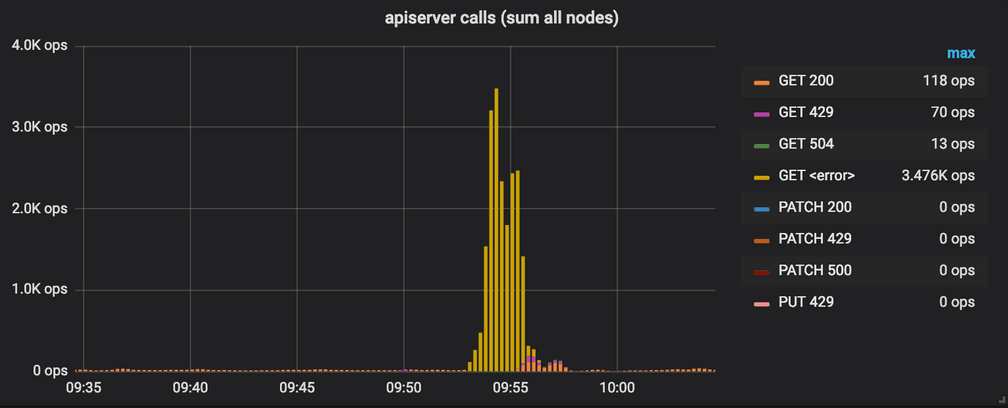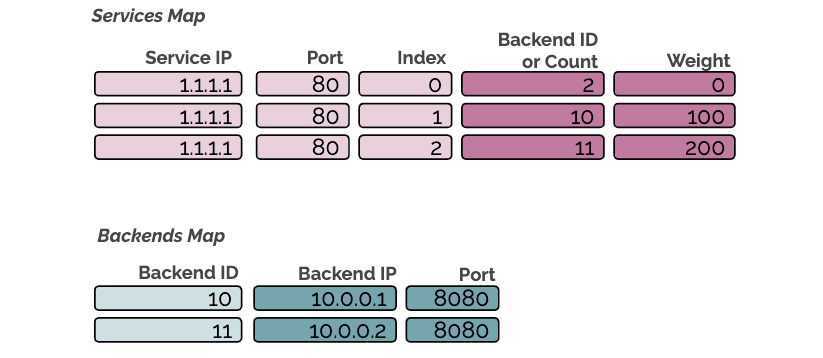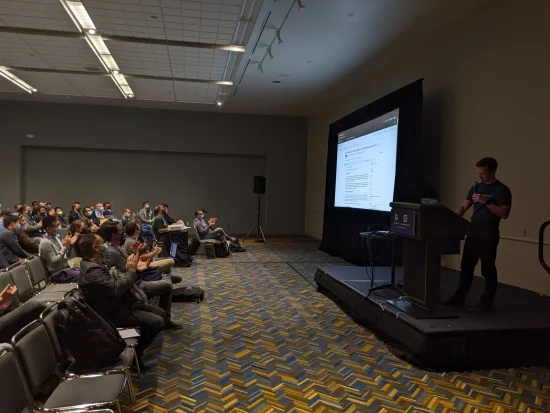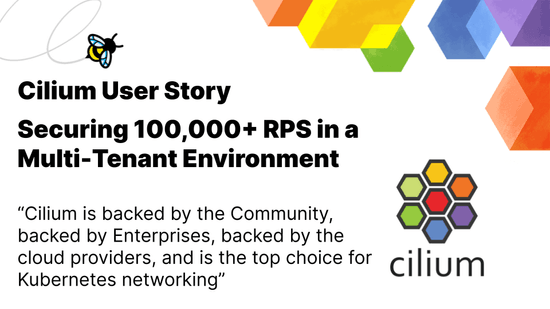Cilium 1.5: Scaling to 5k nodes and 100k pods, BPF-based SNAT, and Rolling Key Updates for Transparent Encryption
We are excited to announce the Cilium 1.5 release. Cilium 1.5 is the first release where we primarily focused on scalability with respect to number of nodes, pods and services. Our goal was to scale to 5k nodes, 20k pods and 10k services. We went well past that goal with the 1.5 release and are now officially supporting 5k nodes, 100k pods and 20k services. Along the way, we learned a lot, some expected, some unexpected, this blog post will dive into what we learned and how we improved.
Besides scalability, several significant features made its way into the release including: BPF templating, rolling updates for transparent encryption keys, transparent encryption for direct-routing, a new improved BPF based service load-balancer with improved fairness, BPF based masquerading/SNAT support, Istio 1.1.3 integration, policy calculation optimizations as well as several new Prometheus metrics to assist in operations and monitoring. For the full list of changes, see the 1.5 Release Notes.
As usual, a big shout out to the entire community of Cilium developers who have contributed 1336 commits in the last 2 months between version 1.4 and 1.5.
What is in this post?
- Deep Dive into Scalability Improvements
- BPF Templating: Avoiding BPF compilations
- BPF-based masquerading support: On the last Mile to removing kube-proxy
- Policy Calculation Optimization
- Optimized Load-Balancing
- 1.5 Release Notes
- What's on the roadmap for 1.6
What is Cilium?
Cilium is open source software for transparently providing and securing the network and API connectivity between application services deployed using Linux container management platforms like Kubernetes, Docker, and Mesos.
At the foundation of Cilium is a new Linux kernel technology called BPF, which enables the dynamic insertion of powerful security, visibility, and networking control logic within Linux itself. BPF is utilized to provide functionality such as multi-cluster routing, load balancing to replace kube-proxy, transparent encryption using X.509 certificates as well as network and service security. Besides providing traditional network level security, the flexibility of BPF enables security with the context of application protocols and DNS requests/responses. Cilium is tightly integrated with Envoy and provides an extension framework based on Go. Because BPF runs inside the Linux kernel, all Cilium functionality can be applied without any changes to the application code or container configuration.
See the section Introduction to Cilium for a more detailed general introduction to Cilium.
Scalability
Thank You: we would like to thank Google for providing us with Google Cloud credits to run extensive scalability tests and benchmarks.
On our quest to unlocking scalability, we have encountered several challenges. Some of them were expected problems known to most software engineers:
Fixed re-sync intervals: A sanity re-sync of state every 5 minutes looks harmless at 100 nodes with 0.33 ops/s but grows to 16.6ops/s when scaling to 5K nodes.
O(n^2) algorithms: While harmless at a few dozen nodes, a no-go at 5K nodes or 100k pods.
Missing exponential back-off: These are typically more subtle and often come into play after the cluster has successfully scaled up slowly followed by sudden synchronized failure across many nodes. Without exponential back-off, the load of retries may exceed the capacity of centralized resources and a cluster may never recover again.
Missing jitter for intervals: This causes unnecessary alignment of actions towards centralized resources such as the Kubernetes apiserver. Failures due to these appear randomly and are hard to track down. While we never reproduced this type of problem, we introduced jitter into all major timer intervals to be safe.
Other challenges were a bit more surprising:
Scaling Kubernetes watchers: The sheer size of some Kubernetes resources makes it challenging to scale watchers across large clusters without consuming significant network bandwidth. The issue itself was expected, the dimension of this problem was a surprise, we measured 400Mbit/s of network traffic when running a 2K nodes cluster with the standard node heartbeat intervals.
etcd panic: A bug in grpc-go can cause etcd to close an already closed go channel resulting in a panic. Above a certain scale, we started seeing this very frequently and it caused a lot of disruption.
Dealing with apiserver server-side rate-limiting: This is less of a problem with self-managed Kubernetes clusters but all managed Kubernetes services we have tested with impose server-side rate-limiting of the apiserver. For most of them, the rate limiting is dependent on the cluster size. When scaling up quickly, the rate limiting can lag behind significantly.
New Unlocked Scalability
We have performed a wide set of scale tests to identify and push the limits. Starting with Cilium 1.5 we will be comfortable to support clusters up to the following size:
- 5k nodes
- 100k pods
- 20k services[*]
Note: The scalability of services will depend heavily on whether and how you are running kube-proxy. Operating kube-proxy in iptables mode can cause considerable CPU consumption due to requiring several individual iptables rules for each service backend. It is already possible for Cilium users to remove kube-proxy entirely if you are not relying on NodePort. Starting with Cilium 1.6, NodePort will be natively support with BPF as well and kube-proxy can be removed entirely from all nodes.
Can I run bigger clusters? Yes, we don't actually know the exact limit yet as we did not hit any barries so far in our testing. Resource usage on individual nodes is pretty flat.
To illustrate this, the following graph shows resource metrics for a 1k nodes cluster while scaling from 30k pods to 60k pods:
The graph shows min/max/avg CPU spent across all nodes (1 vCPU, 2GB RAM) as well as the sum of all kvstore operations performed by the entire clsuter. The CPU consumption on individual nodes is almost flat. This is thanks to the new BPF templating support described later on this post which avoids expensive compilation.
As you grow clusters further, additional resources are primarily required for your centralized services such as the apiserver, Prometheus and the etcd cluster user by Cilium. In this test, we have been running a dedicated 3 node etcd cluster for Cilium and the memory consumption of etcd had grown to about 700MB per instance.
What about interactions with the Kubernetes apiserver? The following graph shows the number of apiserver interactions per second for all nodes combined while scaling from 30K to 60K pods:
The GET calls are done to retrieve pod labels of new pods for network policy
evaluation. The DELETE calls are agents removing custom resources with
potential conflicting names. Doing a DELETE is cheaper than doing a GET
first followed by a DELETE if needed. The POST and PATCH calls are used
to create and update CiliumEndpoint custom resources. By using PATCH as
available with k8s >=v1.13.0, it is no longer required to keep a local copy of
these resources.
Glitch in the Matrix: etcd panics
Did you know that for a Go select statement with multiple cases, when
multiple communication operations are met, the execution order of the
processing block is random?
It was a bit of a surprise that we were the first to hit this etcd panic as it was quite simple to reproduce above several hundred nodes. The bug was not in etcd itself but in grpc-go and has been fixed by gprpc-go PR#2695. etcd PR#10624 has been opened as well to rebase on top of the fixed grpc-go.
Scaling Kubernetes Events
Cilium uses the Kubernetes node resource to detect other nodes in the Kubernetes cluster and pod resources to learn which pod is running on which node and to derive the pod labels to implement network policies.
As much as we love the standard Kubernetes resources for nodes, they do not scale very well when attempting to register a standard Kubernetes ListAndWatch from every ach worker node in a larger cluster. This is for two main reasons:
The node resource is used to detect stale nodes, each node will update a heartbeat field regularly which cause the node resource to change every couple of seconds. Each of those changes is being reflected to all listeners, in this case several thousand worker nodes. The issue is being addressed in Kubernetes via KEP-009 using a new NodeLease feature. You can further details about this in the section Node Controller of the Kubernetes documentation.
As many other resources, the node resource has grown over time. Even with ProfoBuf serialization enabled, transmitting the entire node resource to all worker nodes on each change of the resource results in significant load in bytes transmitted over the network and in CPU cycles spent to serialize and deserialize the large resource so often. This is made worse by the fact that only some of the fields in the resource are relevant to Cilium so the majority of events are sent unnecessarily.
The following graph shows the ratio of events that were necessary or unnecessary to be received while scaling a GKE cluster from 0 to 2000 nodes and back:
In order to optimize this, Cilium 1.5 includes a new optimization to allow offloading events from Kubernetes to a more efficient notification channel via etcd watchers:
This resolves both of the previously described problems, etcd will only store a minimal version of the resource with the fields relevant to Cilium and will thus only distribute an event when significant fields have changed. It also means that the heavy-weight event is sent once to the single-instance operator and a light-weight event is distributed to the 5000 worker nodes.
Optimizing Kubernetes Resource Caches
Another problem that appears at scale is the amount of memory it requires to maintain resource caches of standard resources such as nodes, services, pods, endpoints, and network policies when using the standard Kubernetes go client via interfaces such as Informers. The cache will store the full-blown resource with all fields defined in a local in-memory cache.
By introducing a slimmed down of various Kubernetes resources that only defines the fields of relevance, the memory consumption of the agent in each node can be reduced significantly. The graph above shows the difference in memory consumption in a 2K nodes GKE cluster.
Dealing with apiserver rate-limiting
In order to gain visibility into how successfully Cilium interacts with the Kubernetes apiserver, we have introduced a Prometheus metric which keeps track of number of interactions per resource as well as track the return codes and latency as histogram.
The following shows an attempt to scale up from 3 to 5K nodes without any optimizations. While cloud providers have no problem to provision 5k nodes in parallel, 5k nodes suddenly hitting the apiserver to register themselves clearly overloads the apiserver:
The apiserver is so undersized that it gets overwhelmed immediately and calls to the apiserver will simply timeout and several thousand apiserver calls fail per second (yellow bars). Note that the graph only shows the interactions as performed by the apiserver, in parallel, kubelet and kube-proxy will also interact with the apiserver, adding more load to the system. This is not represented in this graph.
Shouldn't the apiserver get resized and become more powerful? Yes, but it requires the cluster to grow first which requires kubelet to be successful in starting up. This depends on successful interactions with the apiserver. A classic chicken and egg situation. It also requires kubelet to continue being successful in updating the heartbeat timestamps of the node resource or the node will be marked stale again.
The major optimization that we found is to fail less quickly. Standard software engineering principles typically suggest to fail quickly when unexpected errors occur such as inability to communicate with the apiserver. kubelet will restart Cilium and the operation will be retried. This strategy has a major drawback, during the bootstrap process, Cilium performs multiple calls to the apiserver to retrieve services, endpoints, nodes, and network policies. A successful start of Cilium requires all of these calls to succeed. Assuming that the first 3 calls have succeeded and the fourth fails, Cilium fails, will be restarted and has to start from the first call again.
With the smarter failure strategy in place, dangerous restart cycles can be avoided and the apiserver is resized successfully. The new apiserver is now capable to handle the requests from a load perspective but the rate is above the server side rate limiting and the apiserver will return HTTP error codes 429 (magenta bars), at the same time, the number of successful apiserver calls increases until the cluster has been scaled up (orange bars). Once the cluster is scaled up, the number of interactions returns to the regular idle level.
BPF Templating: Avoiding BPF compilations
Section contributed by Joe Stringer
Cilium is designed to tailor the datapath forwarding logic for each individual endpoint, minimizing the number of instructions required to apply security and determine how to forward traffic to its destination. To achieve this, any endpoint-specific information such as IP addresses is compiled directly into the machine-code instructions in BPF, unused features are compiled out, and security policies specific to the endpoint are implemented via O(1) map lookups. In prior versions of Cilium, the agent would invoke the C to BPF compiler each time an endpoint runs, meaning that if you run a hundred endpoints on a node, that node would spend a lot of time and CPU preparing the datapath for each of those many endpoints.
In Cilium 1.5, we implemented BPF templating which compiles the BPF programs once when Cilium starts up, then injects endpoint-specific information into the compiled BPF ELF files for each endpoint when the endpoint starts. This process is about 25x faster than invoking the compiler every time, and greatly speeds up the deployment of new pods into your cluster---particularly at high scale. CPU requirements for Cilium are also drastically decreased as a result. Users running any supported kernel with Cilium 1.5 will benefit from these changes, but we've been working with the Linux community to further improve support for BPF templating, which will be part of the Linux 5.2 release later this year.
BPF-based masquerading support
Contributed by Daniel Borkmann
A native BPF-based SNAT engine has been implemented as part of Cilium's BPF datapath. This allows to replace the iptables-based NAT machinery through more efficient, native BPF when the masquerade option is enabled in the Cilium agent as well as iptables rule setup disabled.
For the initial 1.5 merge, we have enabled Cilium's IPVLAN datapath to use BPF-based masquerading. Later minor releases will bring Cilium's veth datapath on parity as well. For ipvlan, this has the unique advantage that the datapath can be operated with masquerading in the more efficient L3 mode instead of having to fall back to L3S to fix the netfilter symmetry problem. In the latter case, it is required for masquerading to pass netfilter hooks in host namespace on ingress as well as egress which is not the case in L3 mode, and therefore the switch to one of the ipvlan slaves must be performed at a late point in time out of a custom ipvlan netfilter hook in L3S mode. Thanks to BPF-based masquerading, these limitations are gone and ipvlan can operate normally and perform slave-switching directly at its receive hook out of L3 mode.
The BPF-based masquerading in Cilium works together with Cilium's BPF-based
connection tracker and has been integrated be to attached to external-world
facing devices, but can flexibly be attached to host internal devices as
well. Masquerading is supported for IPv4 as well as IPv6 for protocols TCP,
UDP, ICMP and ICMPv6 right now. For example, for both ICMP protocols, echo
request / reply identifiers are translated and remapped in case of collisions.
The BPF SNAT engine first tries to retain ports or identifier from the packet
in order avoid L4 packet rewrites, but in case of collisions with existing
mappings, it will select a different one. In case of L3 for host-based
connections, it avoids rewrites altogether if the tuple can be retained
as-is. The Cilium daemon has a set of new commands under cilium bpf nat
for introspecting the NAT table similarly as with the Cilium connection
tracking tables.
Policy Optimizations
Section contributed by Ian Vernon
Significant progress has been made in Cilium v1.5 in the policy subsystem. The
policy subsystem is responsible for computing the policy for a given endpoint
by iterating over all rules which select an endpoint, and transforming these
rules into a representation which the BPF datapath and proxies can understand.
Starting in v1.5, we began working on a substantial redesign of how policy is
plumbed for a given endpoint, which will bring large performance gains in
future releases of Cilium. Part of this redesign included the effort to only
compute the policy for an endpoint if truly necessary. Previously, upon any
policy change in Cilium (e.g., CiliumNetworkPolicy being imported) across the
entire cluster, each Cilium agent would re-compute the policy for all endpoints
on its local node, even if the policy which was imported had no effect for some
endpoints. Now, Cilium analyzes the content of the change in rules, and only
regenerates the endpoints which the added rules select. This significantly
reduces the amount of endpoint regenerations which occur on a given node when
there is a high amount of change in the state of rules on a given node. Such a
state is common in the case where rules which contain toFQDNs policy that
select an endpoint on the node, as such rules can update the policy repository
on a given node quite frequently as new IPs are resolved via DNS which
correspond to the FQDNs in the rules.
New Optimized Load Balancing
Section contributed by Martynas Pumputis
Cilium provides a BPF-based loadbalancing capability which can be used to
replace the kube-proxy implementation of services of the ClusterIP type. The
former does not rely on the iptables and conntrack kernel modules.
Therefore, it has a better performance, and it does not suffer from the various
conntrack race conditions which e.g. can cause 5 second timeouts of DNS
requests.
Prior to Cilium 1.5, in the case of a removal of a service endpoint, the loadbalancing mechanism had to replace the removed endpoint entry in the BPF maps with any other endpoint. This was needed to prevent from breaking established connections to the service. Unfortunately, the endpoint entry duplication had a side-effect which could lead to uneven distribution of endpoints serving requests.
In Cilium 1.5, we have addressed the problem by reworking the loadbalancer. In addition, the new loadbalancer no longer needs to duplicate the entries, thus it has a smaller memory footprint. The design document of the new loadbalancer can be found here.
To support a smooth migration to the new loadbalancer for existing users, we
maintain both loadbalancers at the same time. New users or the ones who do not
care about breakage of the existing connections to services can disable the
legacy loadbalancer by passing --enable-legacy-services=false to
cilium-agent. We plan to stop supporting the legacy loadbalancer in Cilium
1.6.
1.5 Release Highlights
- Scalability:
- Own implementation of Kubernetes resource stores with minimal data structure definitions to avoid using bloated Kubernetes types to save memory at large scale.
- Ability to hand-over distribution of Kubernetes node and pods events via kvstore instead of standard watchers for heavily reduced apiserver traffic. (75 vs 5 memory allocations per event).
- New scalable load-balancing implementation which guarantees fairness as service backends scale up & down
- Use of PATCH instead of UPDATE whenever possible and as supported by Kubernetes >= 1.13.
- Liveness of the apiserver is now primarily derived from the last receiving of an event, requiring less pings.
- Several interval have been made dependent on the overall cluster size using a logarithm function to become less aggressive with access to centralized resources as the cluster grows.
- Several garbage collector operations have been moved from the per-node agent into the single-instance operator for reduced load on the apiserver.
- The ability to rate-limit access to the kvstore has been added
- Jitter has been added to exponential backoff intervals to avoid aligning many nodes close to certain timestamps.
- The cost of keeping the CliumEndpoint CRD up-to-date has been reduced.
- New connection tracking garbage collector interval tailored to the BPF map type in use to minimize CPU overhead and to minimize risk of connections being dropped when oeprating at the table limit: 12 hours on new kernels when LRU is in use, 15 minutes on older kernels.
- BPF Templating:
- Compilation of BPF programs are now done through the use of templates which allow to reuse existing compilation artifacts. This means that scheduling of additional pods onto a node no longer requires compilation of BPF programs with LLVM. This reduces the CPU overhead and pod spin-up time.
- Options with large runtime impact are still done at compile time, the cost of recompilation is paid once per node and can then be re-used by all other pods on the same node.
- A new CLI tool
bpf templateis available to list and describe templates. - Rebase to LLVM 7
- Transparent Encryption:
- Support for rolling key updates
- Support for direct-routing datapath mode
- Switch to more efficient GCM-128-AES algorithm by default
- Ability to encrypt communication of pods not managed by Cilium
- Automatic MTU correction to account for network header overhead
- Policy:
- More intelligent selection of which endpoints need their policy re-calculated on the event of policy rule changes (CiliumNetworkPolicy and NetworkPolicy).
- Networking:
- BPF based SNAT in IPVLAN mode which allows to enable masquerading in
the more efficient IPVLAN L3 mode. This is a drop-in replacement for
the iptables based masquerading which can only operate at a less efficient
L3S mode. Later minor releases will bring the Cilium VETH based data
path on par with supporting BPF based SNAT. A new CLI tool
bpf nathas been added for introspection of NAT mappings. - Additional visibility into IPAM layer (pod name, health IPs, router IPs)
- BPF based SNAT in IPVLAN mode which allows to enable masquerading in
the more efficient IPVLAN L3 mode. This is a drop-in replacement for
the iptables based masquerading which can only operate at a less efficient
L3S mode. Later minor releases will bring the Cilium VETH based data
path on par with supporting BPF based SNAT. A new CLI tool
- Istio:
- Support for Istio 1.1.3
- New Prometheus Metrics:
- kvstore operation (duration histogram)
- All BPF system calls (duration histogram)
- BPF map accesses (duration histogram)
- API calls made to the agent (duration histogram)
- All Kubernetes apiserver & events interactions (duration histogram)
- FQDN proxy & cache statistics
- Kubernetes:
- Kubernetes 1.14 support
- New optimized initContainer for state cleanup and preflight checks
- The CNI configuration is no longer removed on pod exit
- The DaemonSet definition no longer lists all environment variables, the ConfigMap is mounted as a directory into the pod and the agent reads the directory automatically.
Upgrade Instructions
As usual, follow the upgrade guide to upgrade your Cilium deployment. Feel free to ping us on Slack.
Release
- Release Notes & Binaries: 1.5.0
- Container image:
docker.io/cilium/cilium:v1.5.0
Outlook: Roadmap for Cilium 1.6
Native AWS ENI allocation support
Native AWS ENI allocation will allow to use AWS ENI addressing in combination with Cilium. Quite unique to the implementation will be pre-allocation of ENI adapters and addresses based on quotas as well interaction with the AWS API via the centralized operator to have control over the rate of interactions with the API to avoid rate limiting to affect cluster operation and scheduling success probabilities. For additional details, refer to the design document.
Optimized Policy Calculation Engine
1.5 has unlocked scalability with regard to number of nodes, pods and services. While the policy scalability is already much better than traditional solutions, there is some leftover potential that we will address in 1.6. The policy engine will become entirely incremental. If you are interested in this topic, join the SIG-Policy meetings to get involved.
Load-balancing for host processes
Load-balancing has only been available to Cilium managed pods so far. With support for host processes, load-balancing will be done at socket level without any need for network packet mangling and will also apply to processes in the init namespace. This will also allow to use Cilium load-balancing in combination with other CNI plugins without requiring to chain the plugins together.
kube-proxy removal
Cilium 1.5 has introduced the BPF SNAT datapath capability. With Cilium 1.6, we
will provide --masquerade=true behavior for non-IPVLAN modes and also provide
a NodePort implementation.
CNI Chaining API
1.6 will provide a new API to simplify chaining with other CNI plugins to integrate Cilium network policy, load-balancing, transparent encryption and visibility in combination with other CNI plugins. We already have working code for the following plugins which will be made available together with the new API.
If you want to contribute chaining support for additional plugins, feel free to contact us on Slack.
CRD backing for identity allocation
So far, installation of Cilium required either an external etcd or use of the etcd-operator to provide an etcd cluster. PR7573 will provide CRD support for identity allocation which will make etcd entirely optional for operations. As outlined in the scalability section, we will still require etcd to guarantee performance above a certain cluster size.

